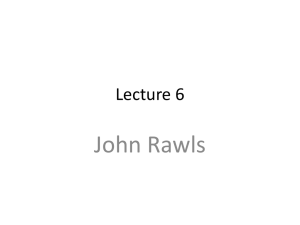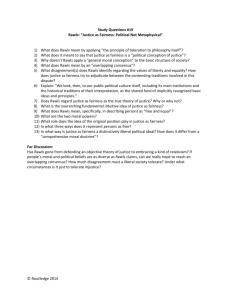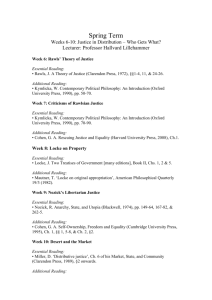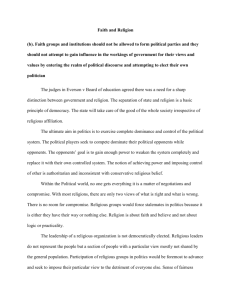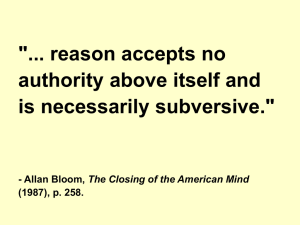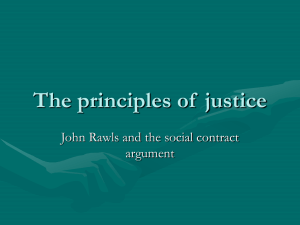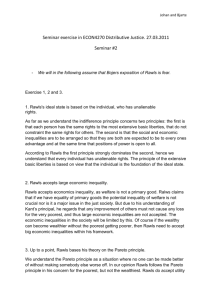Darwall, Stephan. 2009. The Second
advertisement
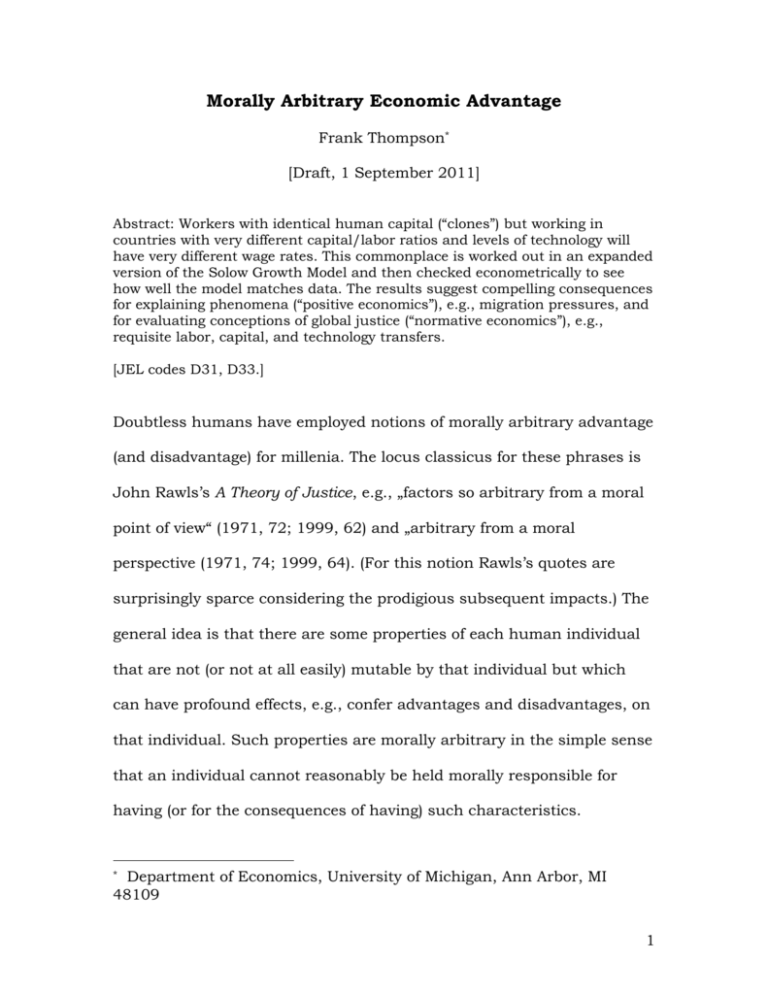
Morally Arbitrary Economic Advantage Frank Thompson* [Draft, 1 September 2011] Abstract: Workers with identical human capital (“clones”) but working in countries with very different capital/labor ratios and levels of technology will have very different wage rates. This commonplace is worked out in an expanded version of the Solow Growth Model and then checked econometrically to see how well the model matches data. The results suggest compelling consequences for explaining phenomena (“positive economics”), e.g., migration pressures, and for evaluating conceptions of global justice (“normative economics”), e.g., requisite labor, capital, and technology transfers. [JEL codes D31, D33.] Doubtless humans have employed notions of morally arbitrary advantage (and disadvantage) for millenia. The locus classicus for these phrases is John Rawls’s A Theory of Justice, e.g., „factors so arbitrary from a moral point of view“ (1971, 72; 1999, 62) and „arbitrary from a moral perspective (1971, 74; 1999, 64). (For this notion Rawls’s quotes are surprisingly sparce considering the prodigious subsequent impacts.) The general idea is that there are some properties of each human individual that are not (or not at all easily) mutable by that individual but which can have profound effects, e.g., confer advantages and disadvantages, on that individual. Such properties are morally arbitrary in the simple sense that an individual cannot reasonably be held morally responsible for having (or for the consequences of having) such characteristics. Department of Economics, University of Michigan, Ann Arbor, MI 48109 * 1 Paraphrasing Rawls’s related metaphor, we are all participants in social and natural lotteries we did not choose to play. Our individual starting points, opportunities, and outcomes depend in part on a social lottery (the political, social, and economic circumstances into which each person is born) and a natural lottery (the biological potentials each person is born with).1 Needless to say there is a volumnious philosophical literature addressing whether, and if so how, these notions can be made precise, and considering what implications employing these notions may have for moral (especially political) philosophy. It would be inappropriate to review that literature in this venue.2 Here the project is much less general: to consider a matter of what is arguably morally arbitrary economic advantage or disadvantage, i.e., the amount of physical capital and the level of technology one works with. Many have come up empty-handed in a search for a definative passage in Rawls’s work specifying morally arbitrary characteristics. But the notion is there, and many have tried to phrase it. A good attempt: „[I]n the distribution of income and wealth people should not benefit from or be held morally responsible for, natural or social advantages or disadvantages they are born with. (Freeman 2007, p. 443.) 1 Perhaps the most influential work since Rawls in this stream is that of Ronald Dworkin, especially his distinction between „option luck“ (with hypothetical insurance against bad outcomes) and „brute luck“ (no insurance) (Dworkin 2000). A more radical critique of Rawls’s position (from the left) is that of G. A. Cohen, e.g., in Cohen 2001 and 2008. Also essential for understanding this terrain is work by Amartya Sen, e.g. Sen 2011. 2 2 Thus consider two individuals, i and j , supplying labor input Li and L j in perfectly competitive economies. Where Ai and Aj are the levels of technology and K i and K j are the stocks of capital individuals i and j respectively work with, and hi and h j are their respective levels of human capital, their respective outputs will be Yi Ai F K i ,hi Li and Yj AF Kj ,hj Lj . j Intended is a neoclassical production function with the standard formal properties (constant returns to scale, diminishing returns to factors, the Inada conditions) augmented with a level of technology shift parameter and with a human capital index qualifying the labor input. Calling the shift parameter “technology” is of course sloppy (but common). It is the Solow residual, “total factor productivity,” and thus “a measure of our ignorance.”3 Under perfect competition each will be paid per unit of their labor supplied its marginal product, i.e., wi Yi Li Ai F Ki , hi Li hi Li hi and Of course some very interesting work is ongoing in the attempt to decompose the Solow residual into components less opaque and perhaps independently measurable. An approach is to set A T E where T is the level of technology and E is (residual) efficiency, but measuring is problematic. (See Weil 2009, p. 276.) 3 3 w j Y j L j A j F K j ,h j L j h L h . j j j Now suppose that Ai A j and K i K j , e.g., individual i works with better technology and more capital than does individual j , but that hi h j , i.e., i and j are clones in the quality of the labor they supply. Under these circumstances it will be the case that w i w j . Does individual i somehow deserve the extra w i w j per each unit of labor worked? (John Bates Clark would have thought so.) More concretely, consider a Cobb-Douglas case in which, Ai 2 , A j 1, Ki 2, K j 1, hi h j 1, and F, . Then Yi 2 21 3 L2i 3 and 13 while wj 2 3Lj . If these clones, i and j , 13 23 3 Y j L2j 3 , and wi 4 321 3 L1 i supply equal amounts of labor, wi w j 4 3 21 3 2 3 2 2 13 2.52 , i.e., individual i receives a 152% higher return to labor supplied than does individual j . Does individual i somehow deserve to enjoy a 152% higher return to labor supplied than individual j ? Does individual j deserve to receive a 66% lower return to labor supplied than individual i ? “The question is, how does the massive differential treatment of people who are alike in every respect except their affiliation with a particular nation-state, an 4 essentially arbitrary condition of birth, square with any theory of justice?” (Prichett, 2010, p. 281)4 Of course comprehensive data on the capital or technology used by individual workers is not available.5 There is some sectoral data at least for the capital/labor ratio (the ratio is higher in petroleum refineries than in childcare facilities and the level of technology is doubtless higher as well), but there seems to be no comprehensive data set presenting the different capital/labor ratios (not to speak of levels of technology) by sectors in different countries. To move to international comparisons we must make do with country averages (even though software engineers in Bangalore doubtless work with technology and capital much more like that used in Silicon Valley than the Indian average) and thus move to the per-unit-of-labor version of the neoclassical production function with technology and human capital. Thus in the Cobb-Doublas specification output-per-unit-of-labor is: Y AK hL 1 Y L AK hL 1 L AK L h 1 Y L y; K L k y Ak h1 And the marginal product of labor is: mpl Ak 1 h1 . 4 The current paper and Pritchett 2010 are complements, not substitutes. If one’s clone has a better computer (higher A But one knows what it could show. and K ), one’s clone can create more output per unit of labor expended. 5 5 To taunt more concretely, consider first only a couple of country comparisons, normalizing, AUS kUS 1 and assuming (a standard stylized fact) that uniformly 1 3.6 A worker with country C ’s average level of but supplying labor with the same level of human technology and capital capital as a worker enjoying the US average level of technology and capital, will receive a wage rate only AC kC1 3 100% of that of the US worker. For India AIN 0.39 and kIN 0.04 . Thus an Indian, supplying the same labor with the same level of human capital as a worker in the US, would product) wage rate only 13.3% of that of the Indian’s receive a (marginal US clone. Or consider Zimbabwe with AZW 0.03 and kZW 0.07 . A Zimbabwen, supplying the same labor with the same level of human (marginal product) wage capital as a worker in the US, would receive a rate only 1.2% of that of the Zimbabwen’s US clone. It is not generally customary to place a relatively large spreadsheet in the body of the text of a paper instead of in an appendix, and it won’t be done so here. But in this case it is tempting to do so since understanding how the sheet is constructed (and pondering it) is crucial to understanding how the form of morally arbitrary economic advantage (and disadvantage) here at issue can be theorized and made empirically tractable (and to diminish page-flipping). Thus Appendix I. 6 For an interesting look at for the U.S. see Norris 2011. 6 Page-flipping now: h’ is average years of schooling of the population aged 15-64 (not studying) in 2010. Extracted from 2669521.xls at www.oecd.org. This seems to be the best data available proxying for national average levels of human capital.7 h is the h’ for each country divided by the h’ for the US. y’ is GDP (PPP) per capita in 2010. Extracted from the IMF World Economic Outlook Database, April 2011. y is the y’ for each country divided by the y’ for the US. k’ is physical capital per worker in 2000. Extracted from the Online Data Plotter (www.aw-bc.com/weil) accompanying Weil 2009. k is the k’ of each country divided by the k’ of the US. is the capital share of GNI; (1-) is the labor share. Numerals not in italics are extracted from Bernanke, 2002. The numeral in italics, i.e., 0.35, is the world average according to Bernanke, 2002. These y’, k’, , and h’ data provide most of the empirical basis for this paper. A is the Solow residual, total factor productivity, calculated from A y k h1 . mpl’ is the marginal product of labor, calculated from mpl Ak 1 h1 . Thanks to Marcelo Soto at the Instituto de Análisis Económico at UAB (Barcelona) for the lead. 7 7 mpl is the mpl’ of each country divided by the mpl’, of the US. mplc is the marginal product of labor relative to a US worker with the same human capital, i.e. a US clone, calculated from mplc Ak .8 For the topic of this paper the most interesting numbers are those for mplc, the marginal product of labor relative to a US worker with the same human capital, i.e. a US clone. (This is the source of the numbers for India and Zimbabwe in the opening example.) Only Norway has a higher mplc than the US and Zimbabwe has the lowest in the sample. (Keep in mind that these numbers are derived in a model counterfactually assuming perfect competion.) In order to have some idea how the output of this perfectly competive market model compares to actuality one would like to compare the mpl of the model with country average wage data. Unfortunately there seems to be no such data set covering even most of the countries here under consideration. There is a usable data set for the OECD countries. w’ is average annual wages (PPP) (full-time and full-time equivalent in total economy) in 2009. Extracted from OECDStatExtracts. w is the k’ of each country divided by the w’ of the US. This formula assumes that countries have the same as the US, which is never quite the case. Dropping this assumption makes the formula more complex, i.e., 8 Ak if 1 h US ). US 1 which is a function of h (increasing if US US , decreasing 8 There is a reasonably good fit between mplc and w for the OECD data set: But there is no strong reason to suspect it holds up so well for the larger sample including non-OECD countries. Although our consideration thusfar has been static, a dynamic puzzle is that although inequalities in educational achievement have been broadly and dramatically diminishing both between countries and within individual countries for decades (see World Bank 2006, Figure 3.4, Table 3.2, and Figure 3.5; and Barro 2010, Figure 1); international income inequality (an index constructed from country average incomes weighted by country populations) has been declining only because of the growth of average incomes in China and India, i.e., international inequality aside from China and India had grown percipitously in recent decades (see Milanovic 2005, Figure 8.3). And global income inequality (which in contrast to international income inequality takes into account within- 9 country inequality) has been nearly level because of increasing withincountry inequality (see World Bank 2005, Figure 3.9 and 3.10). The model here employed dictates that diminishing international inequality in human capital and increasing international inequality in income (setting China and India aside) are possible only if international inequality in technology levels and/or capital/labor ratios have increased. There seem to be no comprehensive empirical investigations of whether this has actually occurred. Such a study would be extraordinarily challenging to carry out. Data are available to explore the current (static) relationships between inequalities in the international distribution (country averages) of y, h, k9, and A. See Appendix II. It would be facinating to do a similar study for a single country, e.g., the U.S. at the state, county or congressional district, or even postal code level, if only the requisite data were available. Reflecting now on this rudimentary model of the relation between levels of human capital and the return to labor and its application statically to a substantial set of recent data (as well as the suggestion for applying the model longitudinally—difficult as such a project would doubtless be 9 In poor countries most ditches are dug with shovels, in rich countries rather with (airconditioned-cab) backhoes. 10 empirically--), one can reasonably ask what the significance might be of such exercises. The most extensive exposition of Rawls’s position on global justice (a term he would not accept for it) is Rawls 1999, his last work. Famously and controversially Rawls rejects general claims that morally arbitrary facts of nationality and access to technology and capital associated with nationality are morally problematic.10 At the left pole on the spectrum from Rawls’s nationalism are cosmopolitan positions. (To characterize Rawls’s position as the right pole elides the fact that it is surely far to the left of median public opinion on global justice.) Positions between these poles are influentially occupied. The post-Rawlsian cosmopolitan locus classicus is Pogge 1989 (based on his 1983 doctoral dissertation for Rawls). Pogge’s views have continued to evolve (see Pogge 2008). Another especially influential proponent of cosmopolitanism is Darrel Moellendorf (see Moellendorf 2002). Recent literature on global justice is enormous. I’ll slip now at the end to the first person (which is not my wont; surely science should be third person (though a colleague now at Yale from 10 Rawls does argue that wealthy peoples (societies, not individuals) do owe a duty of assistance to „burdened societies“ too poor to rise by their own efforts. Perhaps the most persuasive defense of Rawls’s position is Freeman 2007, Chapter 10. 11 Michigan, Steven Darwall (2009), argues that some moral science is essentially second-person)). Most of this paper is (at least putatively) positive economics: math (thanks to Bob Solow) and stats (thanks to a horde of colleagues doing work I could not imagine doing). The positive part is (at least to me) quite fascinating, e.g., showing that differences in capital/labor ratios and levels of technology account for far more of differences in workers’ outcomes than their differences in human capital. Another positive topic of great interest is the effect of the relation between the evolution of levels of international and global income inequality and the evolution of levels of human capital on migration pressures.11 But what are we to make of this normatively? (I am a moral realist; ethics is also (at least potentially) science.) I’ve thought about the normative part far more over a long time than I have the positive part. But I’ve made much less progress in coming to broad conclusions in the former.12 11 See for example World Bank, 2005, Figure 10.1, for evidence that wage rate differentials between countries net exporting workers and those net importing workers were enormously greater in the 1990s than in the 1870s). 12 If one holds that the technology and capital available to individuals is morally arbitrary, the case for loosening immigration barriers is prima facia very powerful. See Pritchett, 2010, and Clemens, 2011. Of course there are other arguments for restricting immigration, e.g., that it can endanger the viability of unique national cultures, which must be considered. Perhaps the most influential proponent of the national cultural argument is David Miller (Miller, 2007), e.g., that it can endanger the viability of unique national cultures, which must be considered. Perhaps the most influential proponent of the national cultural argument is David Miller (Miller, 2007). 12 My gut normative intuition is that, ceteris paribus, human capital clones should have the same opportunities to flourish. But many disagree. And whether such equal opportunity is somehow feasible is questionable. It might be only an optimistic hope that such can be.13 13 Cf.: “Although a form of altruism circumscribed parochialism is in our legacy, it need not be our destiny. The fact that altruism and parochialism may have a common evolutionary origin, whether cultural or genetic, does not mean that the two are inseparable.” (Bowles and Gintis, 2011, p. 147.) I.e., can we become nonparochial in our judgments of whether arbitrary differences in our access to capital and technology should affect the expected returns to using our human capital? 13 Appendix I See attached. Appendix II14 The object is to compare inequalities in the distribution of y, h, k, and A by constucting and comparing Lorenz curves for each. Where N is the population of each country15, for each variable x one plots N/cumN on the abscissa and (x/cumx)(N/cumN) on the ordinate.16 Lorenz curve for h (human capital) 14 The underlying Excel and Mathematica files are available from the author. 15 Most recent estimate. Extracted from wiki/List_of_countries_by_population. 16 Cumx is the cumulative amount ordered (lowest to highest) of the variable up to x for this 79 country (80% of world population) sample. 14 Lorenz curve for y (per capita GDP) Lorenz curves for h and y N.B.: income is much more unequally distributed than human capital. 15 Lorenz curve for k (capital/labor ratio) Lorenz curves for h and k N.B.: Physical capital is much more unequally distributed than human capital. 16 Lorenz curve for A (total factor productivity) Lorenz curves for h and A N.B.: human capital is somewhat more unequally distributed than productivity in the middle of the distribution, but less unequally distributed higher in the distribution. 17 That human capital and total factor productivity track each other fairly closely is no surprise. One needs the human capital in order to operate the technology. Profoundly, what explains that income is much more unequally distributed than human capital is the inequality in the distribution of physical capital. Of course levels of human capital should be increased, which historically has been accompanied by decreasing inequality in the distribution of human capital. But one should focus on the fact that inquality in the distribution of physical capital available to workers is what fundamentally determines inequality in the distribution of income. 18 Bibliography Barro, Robert J., and Jong-Wha Lee. 2010. „A New Data Set of Educational Attainment in the World, 1950-2010.“ NBER Working Paper Series, Paper 15902. Bernanke, Ben S., and Refet S. Gürkaynak. 2002. „Is Growth Exogenous? Taking Mankiw, Romer, and Weil Seriously.“ NBER Macroeconomics Annual 16, 2001, pp. 11-57. Bowles, Samuel, and Herbert Gintis. 2011. A Cooperative Species: Human Reciprocity and Its Evolution. Princeton. Clemens, Michael. 2011. „Economics and Emigration: Trillion-Dollar Bills on the Sidewalk?” Journal of Economic Perspectives 25(3), pp. 83-106. Clemens, Michael, Claudio E. Montenegro, and Lant Pritchett. 2009. „The Place Premium: Wage Differences for Identical Workers across the U.S. Border.“ HKS Faculty Research Working Papers Series, Paper RWP09-004. Cohen, Daniel, and Marcello Soto. 2007. „Growth and Human Capital: Good Data, Good Results.“ Journal of Economic Growth 12(1), pp. 51-57. Cohen, G. A. 2001. If You're an Egalitarian, How Come You're So Rich? Harvard. Cohen, G. A. 2008. Rescuing Justice and Equality. Harvard. Darwall, Stephan. 2009. The Second-Person Standpoint Morality, Respect, and Accountability. Harvard. Dworkin, Ronald. 2000. Sovereign Virtue: The Theory and Practice of Equality. Harvard. Freeman, Samuel. 2007. Rawls. Routledge. Heston, Alan, Robert Summers, and Betinna Aten. 2006. Penn World Table Version 6.2. Center for International Comparisons of Production, Income and Prices at the University of Pennsylvania. Miller, David. 2007. National Responsibility and Global Justice. Oxford. Moellendorf, Darrel. 2002. Cosmopolitan Justice. Westview. 19 Norris, Floyd. 2011. „As Corporate Profits Rise, Workers’ Income Declines.“ New York Times (5 August). Pogge, Thomas. 1989. Realizing Rawls. Cornell. Pogge, Thomas. 2008. World Poverty and Human Rights: Cosmopolitan Responsibilities and Reforms (second edition). Polity. Prichett, Lant. 2010. „The Cliff at the Border.“ In Equity and Growth in a Globalizing World, edited by Ravi Kanbur and Michael Spence, pp. 263286. World Bank. Rawls, John. 1971. A Theory of Justice. Harvard. Rawls, John. 1999. A Theory of Justice (revised edition). Harvard. Rawls, John. 1999. The Law of Peoples. Harvard. Sen, Amartya. 2011. The Idea of Justice. Harvard. Weil, David N. 2009. Economic Growth (second edition). Pearson. World Bank. 2005. World Development Report 2006: Equity and Development. Oxford. 20
